ITC 506 - Assessment 1: Ethical Dilemma Analysis Using DET
VerifiedAdded on 2021/04/21
|5
|1712
|38
Report
AI Summary
This report analyzes an ethical dilemma presented in an IT scenario where a Program Director pressures a team to launch a system without proper testing and encryption. The analysis, using the Doing Ethics Technique (DET), explores the facts of the situation, including the risks of system failure, data breaches, and user dissatisfaction. It identifies the stakeholders affected, such as the client, the company, and the end-users, and outlines the ethical issues at stake, including potential economic and emotional harm. The report then evaluates various options, such as Ken resigning, launching the system untested, or delaying the launch for proper testing, and concludes that delaying the launch to ensure thorough testing is the best course of action to protect the company's reputation and data security. The reference list includes relevant sources that support the analysis.
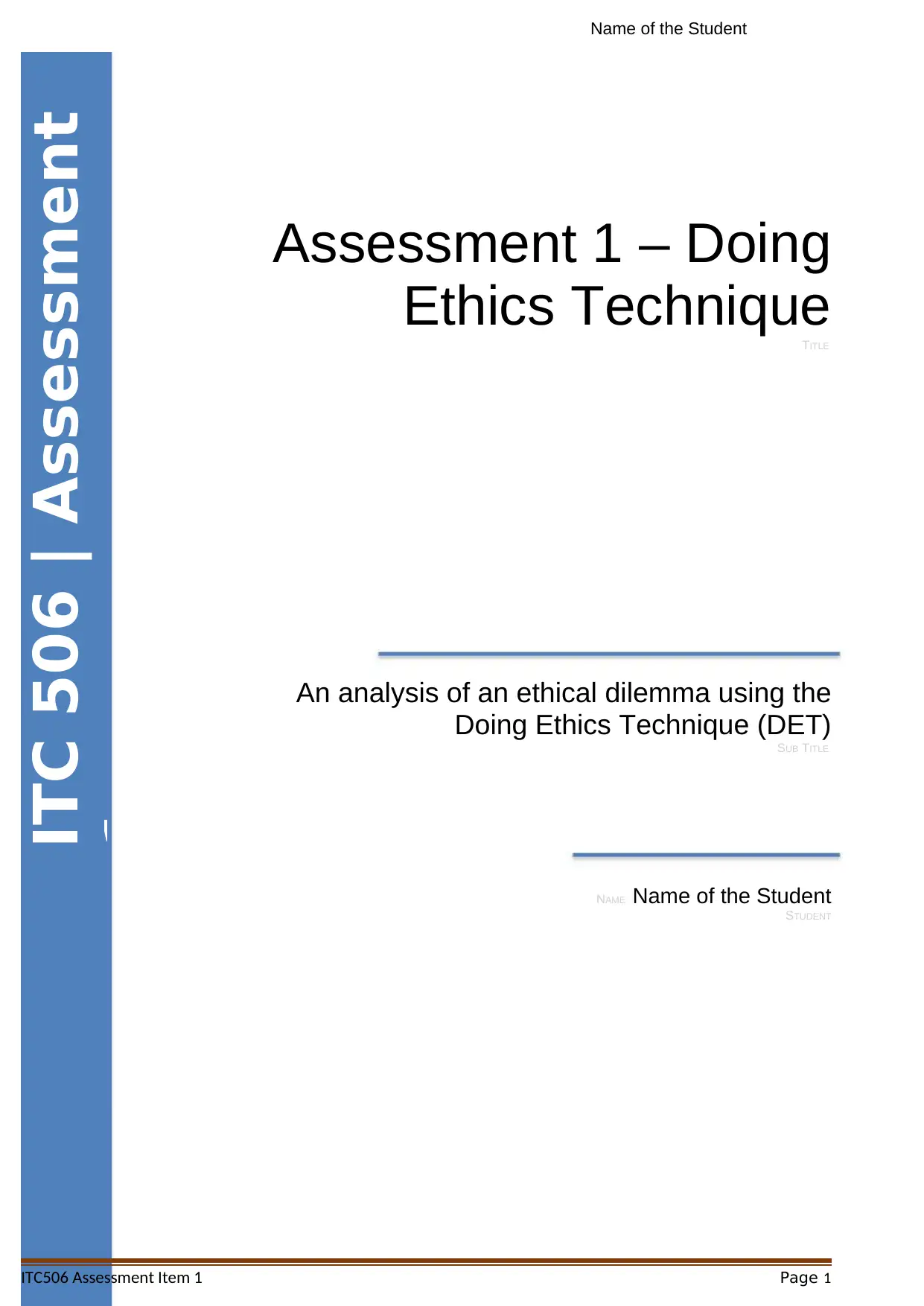
Name of the Student
ITC 506 | Assessment
1
Assessment 1 – Doing
Ethics TechniqueTITLE
An analysis of an ethical dilemma using the
Doing Ethics Technique (DET)
SUB TITLE
NAME Name of the Student
STUDENT
ITC506 Assessment Item 1 Page 1
ITC 506 | Assessment
1
Assessment 1 – Doing
Ethics TechniqueTITLE
An analysis of an ethical dilemma using the
Doing Ethics Technique (DET)
SUB TITLE
NAME Name of the Student
STUDENT
ITC506 Assessment Item 1 Page 1
Paraphrase This Document
Need a fresh take? Get an instant paraphrase of this document with our AI Paraphraser
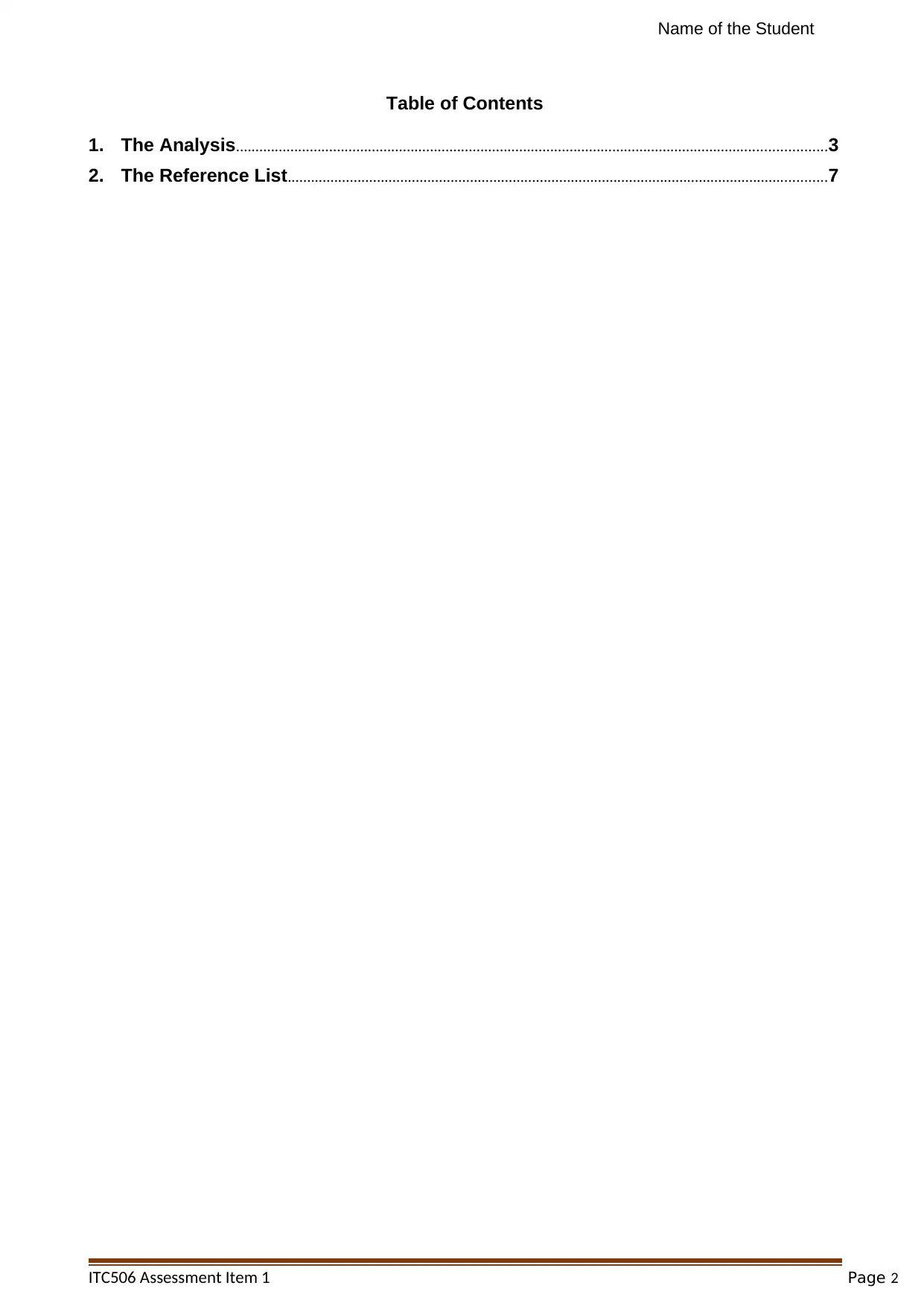
Name of the Student
Table of Contents
1. The Analysis........................................................................................................................................................3
2. The Reference List...........................................................................................................................................7
ITC506 Assessment Item 1 Page 2
Table of Contents
1. The Analysis........................................................................................................................................................3
2. The Reference List...........................................................................................................................................7
ITC506 Assessment Item 1 Page 2
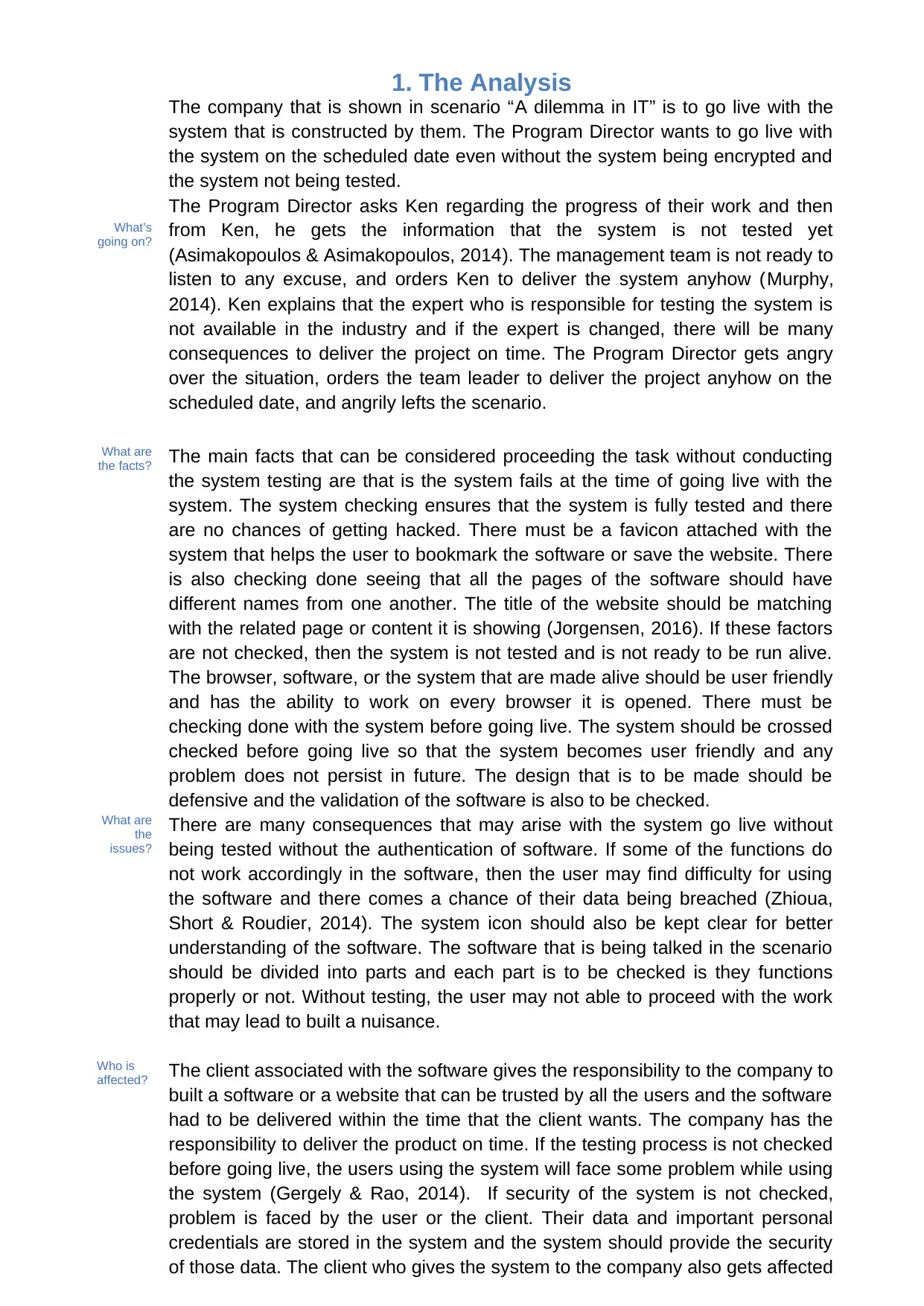
1. The Analysis
What’s
going on?
The company that is shown in scenario “A dilemma in IT” is to go live with the
system that is constructed by them. The Program Director wants to go live with
the system on the scheduled date even without the system being encrypted and
the system not being tested.
The Program Director asks Ken regarding the progress of their work and then
from Ken, he gets the information that the system is not tested yet
(Asimakopoulos & Asimakopoulos, 2014). The management team is not ready to
listen to any excuse, and orders Ken to deliver the system anyhow (Murphy,
2014). Ken explains that the expert who is responsible for testing the system is
not available in the industry and if the expert is changed, there will be many
consequences to deliver the project on time. The Program Director gets angry
over the situation, orders the team leader to deliver the project anyhow on the
scheduled date, and angrily lefts the scenario.
What are
the facts? The main facts that can be considered proceeding the task without conducting
the system testing are that is the system fails at the time of going live with the
system. The system checking ensures that the system is fully tested and there
are no chances of getting hacked. There must be a favicon attached with the
system that helps the user to bookmark the software or save the website. There
is also checking done seeing that all the pages of the software should have
different names from one another. The title of the website should be matching
with the related page or content it is showing (Jorgensen, 2016). If these factors
are not checked, then the system is not tested and is not ready to be run alive.
The browser, software, or the system that are made alive should be user friendly
and has the ability to work on every browser it is opened. There must be
checking done with the system before going live. The system should be crossed
checked before going live so that the system becomes user friendly and any
problem does not persist in future. The design that is to be made should be
defensive and the validation of the software is also to be checked.
What are
the
issues?
There are many consequences that may arise with the system go live without
being tested without the authentication of software. If some of the functions do
not work accordingly in the software, then the user may find difficulty for using
the software and there comes a chance of their data being breached (Zhioua,
Short & Roudier, 2014). The system icon should also be kept clear for better
understanding of the software. The software that is being talked in the scenario
should be divided into parts and each part is to be checked is they functions
properly or not. Without testing, the user may not able to proceed with the work
that may lead to built a nuisance.
Who is
affected? The client associated with the software gives the responsibility to the company to
built a software or a website that can be trusted by all the users and the software
had to be delivered within the time that the client wants. The company has the
responsibility to deliver the product on time. If the testing process is not checked
before going live, the users using the system will face some problem while using
the system (Gergely & Rao, 2014). If security of the system is not checked,
problem is faced by the user or the client. Their data and important personal
credentials are stored in the system and the system should provide the security
of those data. The client who gives the system to the company also gets affected
What’s
going on?
The company that is shown in scenario “A dilemma in IT” is to go live with the
system that is constructed by them. The Program Director wants to go live with
the system on the scheduled date even without the system being encrypted and
the system not being tested.
The Program Director asks Ken regarding the progress of their work and then
from Ken, he gets the information that the system is not tested yet
(Asimakopoulos & Asimakopoulos, 2014). The management team is not ready to
listen to any excuse, and orders Ken to deliver the system anyhow (Murphy,
2014). Ken explains that the expert who is responsible for testing the system is
not available in the industry and if the expert is changed, there will be many
consequences to deliver the project on time. The Program Director gets angry
over the situation, orders the team leader to deliver the project anyhow on the
scheduled date, and angrily lefts the scenario.
What are
the facts? The main facts that can be considered proceeding the task without conducting
the system testing are that is the system fails at the time of going live with the
system. The system checking ensures that the system is fully tested and there
are no chances of getting hacked. There must be a favicon attached with the
system that helps the user to bookmark the software or save the website. There
is also checking done seeing that all the pages of the software should have
different names from one another. The title of the website should be matching
with the related page or content it is showing (Jorgensen, 2016). If these factors
are not checked, then the system is not tested and is not ready to be run alive.
The browser, software, or the system that are made alive should be user friendly
and has the ability to work on every browser it is opened. There must be
checking done with the system before going live. The system should be crossed
checked before going live so that the system becomes user friendly and any
problem does not persist in future. The design that is to be made should be
defensive and the validation of the software is also to be checked.
What are
the
issues?
There are many consequences that may arise with the system go live without
being tested without the authentication of software. If some of the functions do
not work accordingly in the software, then the user may find difficulty for using
the software and there comes a chance of their data being breached (Zhioua,
Short & Roudier, 2014). The system icon should also be kept clear for better
understanding of the software. The software that is being talked in the scenario
should be divided into parts and each part is to be checked is they functions
properly or not. Without testing, the user may not able to proceed with the work
that may lead to built a nuisance.
Who is
affected? The client associated with the software gives the responsibility to the company to
built a software or a website that can be trusted by all the users and the software
had to be delivered within the time that the client wants. The company has the
responsibility to deliver the product on time. If the testing process is not checked
before going live, the users using the system will face some problem while using
the system (Gergely & Rao, 2014). If security of the system is not checked,
problem is faced by the user or the client. Their data and important personal
credentials are stored in the system and the system should provide the security
of those data. The client who gives the system to the company also gets affected
⊘ This is a preview!⊘
Do you want full access?
Subscribe today to unlock all pages.

Trusted by 1+ million students worldwide
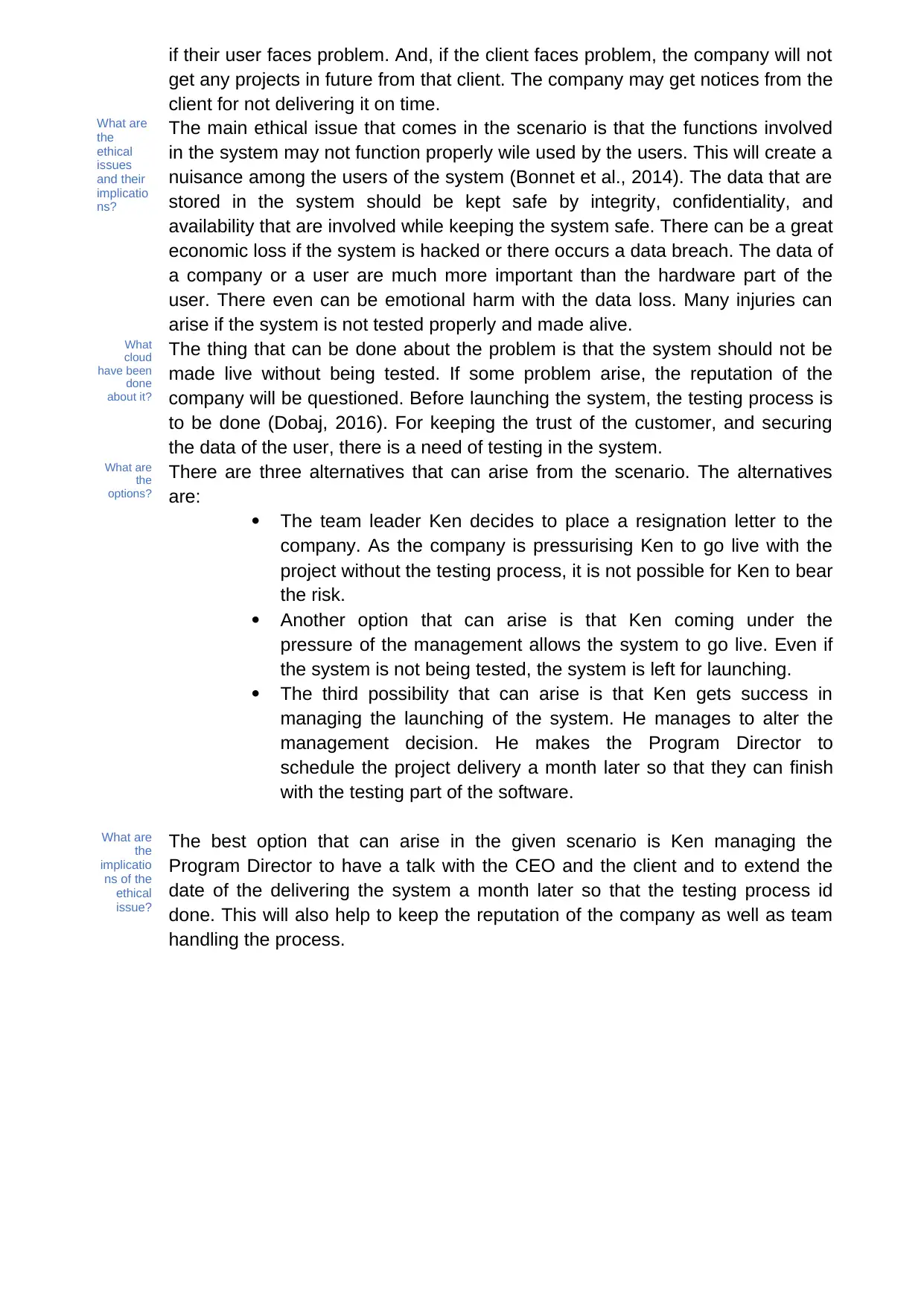
if their user faces problem. And, if the client faces problem, the company will not
get any projects in future from that client. The company may get notices from the
client for not delivering it on time.
What are
the
ethical
issues
and their
implicatio
ns?
The main ethical issue that comes in the scenario is that the functions involved
in the system may not function properly wile used by the users. This will create a
nuisance among the users of the system (Bonnet et al., 2014). The data that are
stored in the system should be kept safe by integrity, confidentiality, and
availability that are involved while keeping the system safe. There can be a great
economic loss if the system is hacked or there occurs a data breach. The data of
a company or a user are much more important than the hardware part of the
user. There even can be emotional harm with the data loss. Many injuries can
arise if the system is not tested properly and made alive.
What
cloud
have been
done
about it?
The thing that can be done about the problem is that the system should not be
made live without being tested. If some problem arise, the reputation of the
company will be questioned. Before launching the system, the testing process is
to be done (Dobaj, 2016). For keeping the trust of the customer, and securing
the data of the user, there is a need of testing in the system.
What are
the
options?
There are three alternatives that can arise from the scenario. The alternatives
are:
The team leader Ken decides to place a resignation letter to the
company. As the company is pressurising Ken to go live with the
project without the testing process, it is not possible for Ken to bear
the risk.
Another option that can arise is that Ken coming under the
pressure of the management allows the system to go live. Even if
the system is not being tested, the system is left for launching.
The third possibility that can arise is that Ken gets success in
managing the launching of the system. He manages to alter the
management decision. He makes the Program Director to
schedule the project delivery a month later so that they can finish
with the testing part of the software.
What are
the
implicatio
ns of the
ethical
issue?
The best option that can arise in the given scenario is Ken managing the
Program Director to have a talk with the CEO and the client and to extend the
date of the delivering the system a month later so that the testing process id
done. This will also help to keep the reputation of the company as well as team
handling the process.
get any projects in future from that client. The company may get notices from the
client for not delivering it on time.
What are
the
ethical
issues
and their
implicatio
ns?
The main ethical issue that comes in the scenario is that the functions involved
in the system may not function properly wile used by the users. This will create a
nuisance among the users of the system (Bonnet et al., 2014). The data that are
stored in the system should be kept safe by integrity, confidentiality, and
availability that are involved while keeping the system safe. There can be a great
economic loss if the system is hacked or there occurs a data breach. The data of
a company or a user are much more important than the hardware part of the
user. There even can be emotional harm with the data loss. Many injuries can
arise if the system is not tested properly and made alive.
What
cloud
have been
done
about it?
The thing that can be done about the problem is that the system should not be
made live without being tested. If some problem arise, the reputation of the
company will be questioned. Before launching the system, the testing process is
to be done (Dobaj, 2016). For keeping the trust of the customer, and securing
the data of the user, there is a need of testing in the system.
What are
the
options?
There are three alternatives that can arise from the scenario. The alternatives
are:
The team leader Ken decides to place a resignation letter to the
company. As the company is pressurising Ken to go live with the
project without the testing process, it is not possible for Ken to bear
the risk.
Another option that can arise is that Ken coming under the
pressure of the management allows the system to go live. Even if
the system is not being tested, the system is left for launching.
The third possibility that can arise is that Ken gets success in
managing the launching of the system. He manages to alter the
management decision. He makes the Program Director to
schedule the project delivery a month later so that they can finish
with the testing part of the software.
What are
the
implicatio
ns of the
ethical
issue?
The best option that can arise in the given scenario is Ken managing the
Program Director to have a talk with the CEO and the client and to extend the
date of the delivering the system a month later so that the testing process id
done. This will also help to keep the reputation of the company as well as team
handling the process.
Paraphrase This Document
Need a fresh take? Get an instant paraphrase of this document with our AI Paraphraser
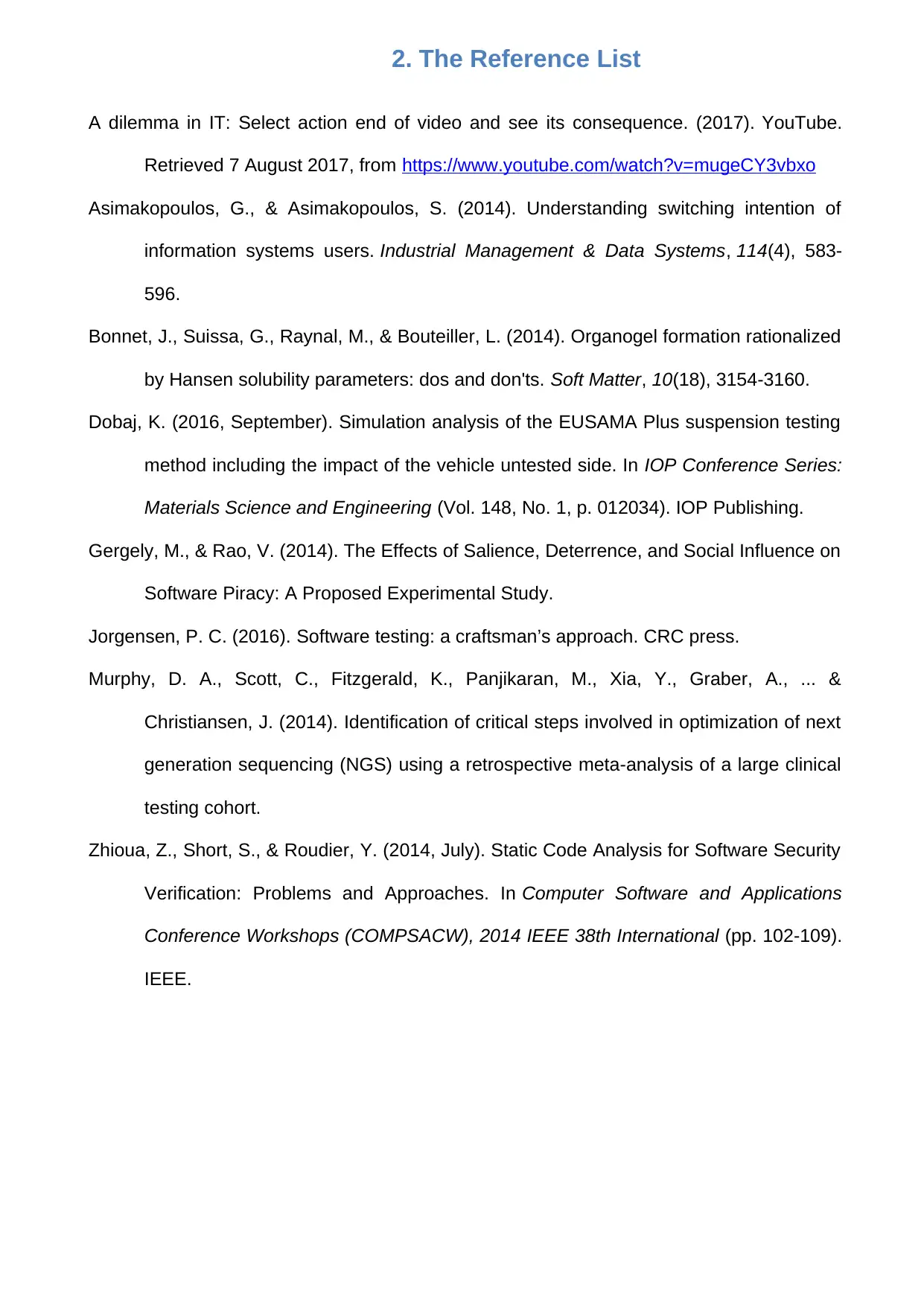
2. The Reference List
A dilemma in IT: Select action end of video and see its consequence. (2017). YouTube.
Retrieved 7 August 2017, from https://www.youtube.com/watch?v=mugeCY3vbxo
Asimakopoulos, G., & Asimakopoulos, S. (2014). Understanding switching intention of
information systems users. Industrial Management & Data Systems, 114(4), 583-
596.
Bonnet, J., Suissa, G., Raynal, M., & Bouteiller, L. (2014). Organogel formation rationalized
by Hansen solubility parameters: dos and don'ts. Soft Matter, 10(18), 3154-3160.
Dobaj, K. (2016, September). Simulation analysis of the EUSAMA Plus suspension testing
method including the impact of the vehicle untested side. In IOP Conference Series:
Materials Science and Engineering (Vol. 148, No. 1, p. 012034). IOP Publishing.
Gergely, M., & Rao, V. (2014). The Effects of Salience, Deterrence, and Social Influence on
Software Piracy: A Proposed Experimental Study.
Jorgensen, P. C. (2016). Software testing: a craftsman’s approach. CRC press.
Murphy, D. A., Scott, C., Fitzgerald, K., Panjikaran, M., Xia, Y., Graber, A., ... &
Christiansen, J. (2014). Identification of critical steps involved in optimization of next
generation sequencing (NGS) using a retrospective meta-analysis of a large clinical
testing cohort.
Zhioua, Z., Short, S., & Roudier, Y. (2014, July). Static Code Analysis for Software Security
Verification: Problems and Approaches. In Computer Software and Applications
Conference Workshops (COMPSACW), 2014 IEEE 38th International (pp. 102-109).
IEEE.
A dilemma in IT: Select action end of video and see its consequence. (2017). YouTube.
Retrieved 7 August 2017, from https://www.youtube.com/watch?v=mugeCY3vbxo
Asimakopoulos, G., & Asimakopoulos, S. (2014). Understanding switching intention of
information systems users. Industrial Management & Data Systems, 114(4), 583-
596.
Bonnet, J., Suissa, G., Raynal, M., & Bouteiller, L. (2014). Organogel formation rationalized
by Hansen solubility parameters: dos and don'ts. Soft Matter, 10(18), 3154-3160.
Dobaj, K. (2016, September). Simulation analysis of the EUSAMA Plus suspension testing
method including the impact of the vehicle untested side. In IOP Conference Series:
Materials Science and Engineering (Vol. 148, No. 1, p. 012034). IOP Publishing.
Gergely, M., & Rao, V. (2014). The Effects of Salience, Deterrence, and Social Influence on
Software Piracy: A Proposed Experimental Study.
Jorgensen, P. C. (2016). Software testing: a craftsman’s approach. CRC press.
Murphy, D. A., Scott, C., Fitzgerald, K., Panjikaran, M., Xia, Y., Graber, A., ... &
Christiansen, J. (2014). Identification of critical steps involved in optimization of next
generation sequencing (NGS) using a retrospective meta-analysis of a large clinical
testing cohort.
Zhioua, Z., Short, S., & Roudier, Y. (2014, July). Static Code Analysis for Software Security
Verification: Problems and Approaches. In Computer Software and Applications
Conference Workshops (COMPSACW), 2014 IEEE 38th International (pp. 102-109).
IEEE.
1 out of 5
Related Documents
Your All-in-One AI-Powered Toolkit for Academic Success.
+13062052269
info@desklib.com
Available 24*7 on WhatsApp / Email
![[object Object]](/_next/static/media/star-bottom.7253800d.svg)
Unlock your academic potential
Copyright © 2020–2025 A2Z Services. All Rights Reserved. Developed and managed by ZUCOL.


